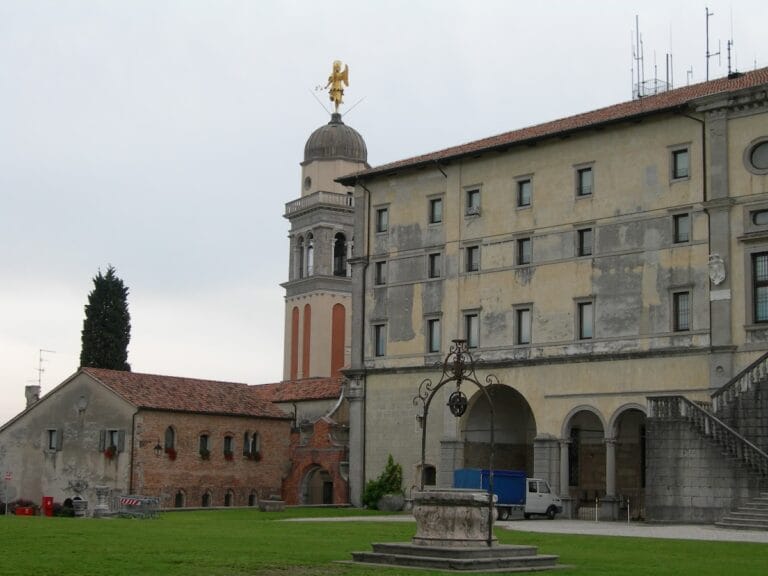Castle of Gemona: A Historic Fortified Residence in Italy
Visitor Information
Google Rating: 4.4
Popularity: Low
Google Maps: View on Google Maps
Official Website: www.archeocartafvg.it
Country: Italy
Civilization: Unclassified
Remains: Military
History
The Castle of Gemona is situated on a hill overlooking the town of Gemona in present-day Italy. Its origins trace back to the settlement efforts around 500 BCE, when early inhabitants established a fortified lookout at a crucial crossroads of Roman roads, serving as a defensive point guarding access to the territory of Noricum.
During the following centuries, this site evolved through various cultural influences, including the Celtic and Carni peoples before becoming a Roman military outpost. The Romans constructed a castrum—a fortified camp—with a watchtower on this strategic hill. Over time, repeated attacks by barbarian groups such as the Quadi and Marcomanni in the late 2nd century CE, the Visigoths under King Alaric in the early 5th century, and the Huns led by Attila mid-century, prompted restorations and strengthening of the fortifications. Later, the site came under the control of the Goths, the Byzantine Empire, and the Lombards during the early medieval period. While no physical remains from these ancient phases have been discovered, written sources like Paul the Deacon reference a Lombard fortress on the site, known as a castrum.
Around the year 1000 CE, the castle was rebuilt entirely by the Lords of Gemona, a noble family whose origins are not well documented. This family secured the castle as a fief from Patriarch Poppone sometime between 1019 and 1042. Over the next centuries, the castle was expanded substantially, especially in the 14th century, when it grew into a large fortified complex with three towers, extensive walls, and a prominent palace. It functioned not only as the noble residence of the Lords but also as a military stronghold and the seat of the patriarchal captain. The castle hosted guard quarters, armories, food storage, a tribunal, and prison facilities.
The castle was also a temporary home for the Patriarch of Aquileia until 1238 and welcomed distinguished visitors, including Emperor Conrad III in 1149, Azzo IV d’Este in 1204, and Emperor Charles IV in 1354. However, a powerful earthquake in 1348 caused significant damage, and parts of the castle were dismantled in 1381. Material from the castle was reused in fortifying the city’s walls and other buildings.
Following the onset of Venetian rule in 1420, the castle gradually fell into disuse. Stones were frequently removed for other construction projects, and the 1511 earthquake inflicted further destruction. Despite this decline, the castle was still regarded as a formidable defense in 1571 against potential Turkish attacks. The site experienced nearly total devastation during the earthquake of 1976. Restoration initiatives began in the early 21st century, leading to the reopening of the gardens in 2008 and the conversion of the clock tower into a museum and exhibition space since 2019.
Remains
The castle complex is perched on a rocky hill at an elevation of 305 meters, accessible by a long stairway known as the Salita dei Longobardi. This stair climbs alongside a defensive wall constructed directly on the exposed rock above a steep descent toward the cathedral. The walls themselves embrace the courtyard and garden areas, providing multiple layers of fortification.
The most conspicuous structure remaining is the clock tower, a square building rising 30 meters tall with walls about 1.5 meters thick. It comprises eight floors, with the lowest level preserving fragments of very ancient masonry from the earliest phases of occupation. Crowning the tower is a battlemented parapet set on top of a cornice, indicative of its defensive and watchtower functions. Access to the top levels is gained through a stone staircase located within the courtyard area enclosed by the castle’s walls. Until the destruction from the 1976 earthquake, this tower also housed the community bell, cast in 1784, which bore inscriptions and images honoring Gemona’s protective saints: Saint Thomas the Apostle, Saint Michael the Archangel, and Saint Anthony of Padua. The bell carried the Latin phrase “HIS DEFENSORIBUS GLEMONA TUTA,” meaning “Gemona is safe under these protectors.”
North of the clock tower stands another tower, identifiable by its tiled roof. This five-story building featured walls roughly two meters thick and served as the castle’s prison from 1826 to 1967. Its substantial construction reflects its function as a secure detention facility. Both towers underwent restoration in the 2000s, with the clock tower ultimately converted into a museum and exhibition space by 2019.
On the southwest corner of the castle grounds lie the remains of a structure known as the “torate.” This area likely served as the main residential quarters for the Lords of Gemona, the patriarchs, and other high-ranking visitors. While fragmentary, these remains provide insight into the living spaces associated with the castle’s noble occupants.
Enclosed within the castle walls, the courtyard contained a multi-tiered garden area, which was likewise shielded by the defensive perimeter. This garden was almost wiped out by the 1976 earthquake but has since been reconstructed and reopened to the public, preserving a green space integral to the castle’s historical layout.
Together, these features illustrate the castle’s role as a fortified residence, administrative center, and local stronghold through many centuries of occupation and transformation.










